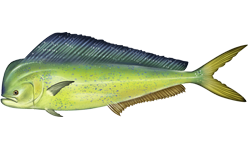Mahi-mahi
This fish related article is a stub.
The mahi-mahi (Coryphaena hippurus), also known as the common dolphinfish, is a surface-dwelling ray-finned fish found in off-shore temperate, tropical, and subtropical waters worldwide. The name "mahi-mahi" comes from the Hawaiian language, meaning "strong-strong," which refers to the fish's fighting ability when hooked.
Taxonomy and Nomenclature[edit | edit source]
The mahi-mahi belongs to the family Coryphaenidae, which includes only one other species, the pompano dolphinfish (Coryphaena equiselis). The scientific name Coryphaena hippurus was given by Carl Linnaeus in 1758. The term "dolphinfish" is often used to describe this species, but it should not be confused with the dolphin, which is a marine mammal.
Morphology[edit | edit source]
Mahi-mahi are known for their vibrant coloration, which includes bright blues, greens, and yellows. They have a compressed body with a long dorsal fin extending from the head almost to the tail. The head is blunt and the mouth is large, equipped with sharp teeth. Adult males, known as "bulls," have a prominent forehead that protrudes above the body, while females, or "cows," have a more rounded head.
Distribution and Habitat[edit | edit source]
Mahi-mahi are found in the Atlantic Ocean, Gulf of Mexico, Caribbean Sea, and the Pacific Ocean. They prefer warm waters and are often found near the surface. These fish are highly migratory and are known to travel long distances in search of food.
Diet and Feeding Behavior[edit | edit source]
Mahi-mahi are carnivorous and feed on a variety of prey, including small fish, squid, and crustaceans. They are opportunistic feeders and are known for their speed and agility in capturing prey. Mahi-mahi often hunt in groups, which increases their efficiency in capturing food.
Reproduction[edit | edit source]
Mahi-mahi are prolific breeders, with spawning occurring throughout the year in warm waters. Females can lay between 80,000 to 1,000,000 eggs per spawning event. The eggs are pelagic, meaning they float in the open water, and hatch within 36 to 48 hours. Juvenile mahi-mahi grow rapidly, reaching maturity in 4 to 5 months.
Economic and Culinary Importance[edit | edit source]
Mahi-mahi is a popular game fish and is highly valued for its firm, flavorful flesh. It is commonly served grilled, baked, or fried, and is a staple in many tropical and subtropical cuisines. The fish is also important to commercial fisheries, with significant catches reported in the United States, Mexico, and Costa Rica.
Conservation Status[edit | edit source]
According to the International Union for Conservation of Nature (IUCN), the mahi-mahi is listed as "Least Concern" due to its wide distribution and high reproductive rate. However, overfishing and bycatch in tuna and swordfish fisheries pose potential threats to local populations.
See Also[edit | edit source]
External Links[edit | edit source]
| Meat | ||||||||||
|---|---|---|---|---|---|---|---|---|---|---|
|
Transform your life with W8MD's budget GLP1 injections from $125
W8MD offers a medical weight loss program NYC and a clinic to lose weight in Philadelphia. Our W8MD's physician supervised medical weight loss centers in NYC provides expert medical guidance, and offers telemedicine options for convenience.
Why choose W8MD?
- Comprehensive care with FDA-approved weight loss medications including:
- loss injections in NYC both generic and brand names:
- weight loss medications including Phentermine, Qsymia, Diethylpropion etc.
- Accept most insurances for visits or discounted self pay cost.
- Generic weight loss injections starting from just $125.00 for the starting dose
- In person weight loss NYC and telemedicine medical weight loss options in New York city available
- Budget GLP1 weight loss injections in NYC starting from $125.00 biweekly with insurance!
Book Your Appointment
Start your NYC weight loss journey today at our NYC medical weight loss, and Philadelphia medical weight loss Call (718)946-5500 for NY and 215 676 2334 for PA
Search WikiMD
Ad.Tired of being Overweight? Try W8MD's NYC physician weight loss.
Semaglutide (Ozempic / Wegovy and Tirzepatide (Mounjaro / Zepbound) available. Call 718 946 5500.
Advertise on WikiMD
|
WikiMD's Wellness Encyclopedia |
| Let Food Be Thy Medicine Medicine Thy Food - Hippocrates |
Translate this page: - East Asian
中文,
日本,
한국어,
South Asian
हिन्दी,
தமிழ்,
తెలుగు,
Urdu,
ಕನ್ನಡ,
Southeast Asian
Indonesian,
Vietnamese,
Thai,
မြန်မာဘာသာ,
বাংলা
European
español,
Deutsch,
français,
Greek,
português do Brasil,
polski,
română,
русский,
Nederlands,
norsk,
svenska,
suomi,
Italian
Middle Eastern & African
عربى,
Turkish,
Persian,
Hebrew,
Afrikaans,
isiZulu,
Kiswahili,
Other
Bulgarian,
Hungarian,
Czech,
Swedish,
മലയാളം,
मराठी,
ਪੰਜਾਬੀ,
ગુજરાતી,
Portuguese,
Ukrainian
Medical Disclaimer: WikiMD is not a substitute for professional medical advice. The information on WikiMD is provided as an information resource only, may be incorrect, outdated or misleading, and is not to be used or relied on for any diagnostic or treatment purposes. Please consult your health care provider before making any healthcare decisions or for guidance about a specific medical condition. WikiMD expressly disclaims responsibility, and shall have no liability, for any damages, loss, injury, or liability whatsoever suffered as a result of your reliance on the information contained in this site. By visiting this site you agree to the foregoing terms and conditions, which may from time to time be changed or supplemented by WikiMD. If you do not agree to the foregoing terms and conditions, you should not enter or use this site. See full disclaimer.
Credits:Most images are courtesy of Wikimedia commons, and templates, categories Wikipedia, licensed under CC BY SA or similar.
Contributors: Prab R. Tumpati, MD











